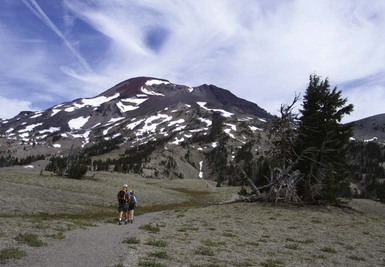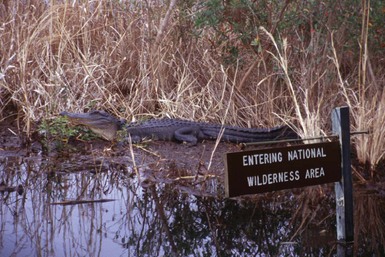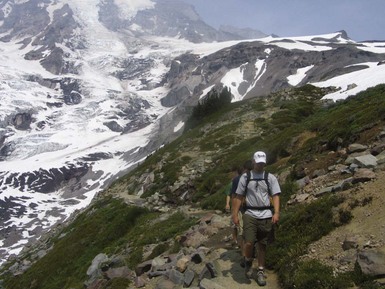Chapter 112 Wilderness Management and Preservation
In the United States and several countries around the world, the word wilderness is associated with a legal definition for places that are legislatively protected.10 The places selected and designated for protection follow certain general guidelines, and this political process is influenced by very strong and diverse groups of stakeholders and the general public. The management objectives for these areas include a variety of values, from preservation of the ecologic conditions and processes to human use and enjoyment (Figure 112-1). Although there is widespread public support for wilderness, there are divergent and polarized viewpoints on how to define wilderness, ranging from extreme protectionists who believe that humans have no place in wilderness to the utilitarian interests that hold that wilderness is a setting for economic development for recreation and tourism activities.
Although there are a variety of definitions of wilderness, the United States has a legal definition of wilderness, albeit somewhat vague, that is the basis for the creation of the National Wilderness Preservation System (NWPS). By 2010, the NWPS included more than 790 management units and more than 109 million acres of publicly owned lands managed by four federal agencies. The purpose of this chapter is to outline the legal designation, management, and preservation of wilderness areas in the United States.5
Historical Development of the Wilderness Concept
The term wilderness historically was used to describe places that were untamed and not under control of humans, whereas civilization was the place of human control.5,12 Areas of civilization that were cultivated and heavily influenced by human activities often bordered or were surrounded by areas that had little human influence. As the population of the world has grown and more land area has come under human influence, wilderness has been lost to the point that it is now scarce in many areas of the world.
There are few places that are not now, or have not been at one time, under human control, habitation, cultivation, or influence. A gradient of human influence and impact exists from urban centers and rural areas to some wild country (e.g., wilderness) that has little or no human influence (Figure 112-2). The so-called human footprint on the world is large and extending rapidly with population growth, road building, food production, power generation, industrialization, and human habitation.14 Some identifiable “last of the wild places” exists on each continent and might continue to do so with careful conservation of resources and protection worldwide of some remaining representative or remnant areas of each ecologic community type.14
Wilderness Legislation and Policy in the United States
The concept gradually evolved that legislative protection was needed to create a more permanent and coordinated national system for wilderness preservation and management. From 1956 to 1964, more than 50 versions of a wilderness bill were introduced in Congress, heavily debated, supported, and challenged by different interest groups. Political compromises were deemed necessary to finally get a wilderness bill passed into legislation, and so certain human activities were permitted in some areas, even though they would be nonconforming with the intent of the wilderness legislation.5,15 These included activities such as mining, grazing, aircraft landings, and water resources development.
In 1964, the U.S. Congress passed The Wilderness Act (U.S. Public Law 88-577).18 This legislation created the NWPS and was heralded by the environmental community and the general public as one of the most important pieces of conservation legislation in U.S. history.15 Scott comments16 that “before there was a Wilderness Act, wilderness was, at best, an afterthought. Only the U.S. Forest Service had actually delineated wilderness areas, propelled by visionaries within its own ranks.”
The Wilderness Act18 defines a broad statement of policy for designating wilderness under the Act and recognizes the need to set aside significant natural areas for present and future generations because of the rapid loss of such resources:
Section 2c of The Wilderness Act18 includes an important and often-quoted definition of wilderness that has led to much controversy and debate because although it is poetic in form, it has left room for interpretation, especially during legal hearings and court cases in the 40 years since its passage:
One of the conditions refers to “outstanding opportunities for solitude or a primitive and unconfined type of recreation”; that phrase is often referred to as the guiding principle for recreation and visitor management. A careful reading of the definition of wilderness makes it clear that preservation is the overall principle and reason for designating an area “wilderness.” Certain types and amounts of recreation are permitted, provided the area is “protected and managed so as to preserve its natural conditions.” This is an important principle to keep in mind when discussing recreation use and management (Figure 112-3), especially when it relates to primitive facilities and trails, backcountry travel, recreational equipment (e.g., removable climbing gear, backpacking stoves), and management interventions.
Creation of the NWPS with the Wilderness Act in 1964 was just the beginning of legislative designations. By 2009, there were more than 170 different laws passed by the U.S. Congress designating new areas or adding acreage to existing areas.5 As Hendee and Dawson9 note, in addition to the Wilderness Act, 40 years of subsequent legislation have clarified congressional intent to protect and manage our nation’s wildest remaining lands as wilderness and has expanded the NWPS…. It is hard to identify any natural resource issue—or any issue—for which Congress has so consistently and so often confirmed their intent as they have with wilderness.
The initial designation of 9.1 million acres of wilderness was followed by congressional designations in 32 of the 45 years between 1964 and 2009 to add additional acres and units to the NWPS (Table 112-1). The largest single increase was the addition of approximately 56 million acres in Alaska under the Alaska National Interest Lands Conservation Act of 1980 (Public Law 96-487).
TABLE 112-1 The Acreage of Wilderness Designated in 1964 at the Creation of the National Wilderness Preservation System and in 5-Year Intervals through 2010
| Year | Acreage |
|---|---|
| 1964 | 9,139,721 |
| 1966-1970 | 1,153,382 |
| 1971-1975 | 2,612,902 |
| 1976-1980 | 68,027,642 |
| 1981-1985 | 8,563,271 |
| 1986-1990 | 5,560,032 |
| 1991-1995 | 8,772,384 |
| 1996-2000 | 1,119,621 |
| 2001-2005 | 1,353,607 |
| 2006-2010 | 3,199,777 |
| Total | 109,502,248 |
From http://www.wilderness.net.
Many proposals for additional units and acreage are still being brought before Congress and its committees. Several authors and organizations have predicted that more acreage will be added to the NWPS in coming decades, but the estimated amount of those additions varies widely.5,15 Scott,16










